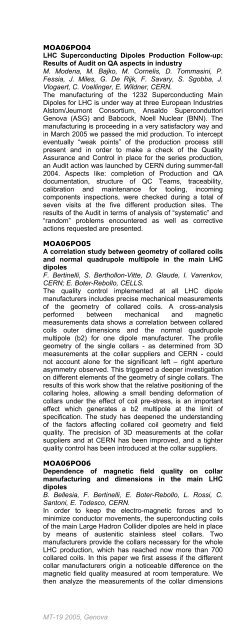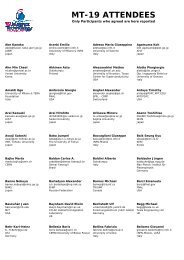Click here to download the abstract booklet in pdf format - MT19 - Infn
Click here to download the abstract booklet in pdf format - MT19 - Infn
Click here to download the abstract booklet in pdf format - MT19 - Infn
You also want an ePaper? Increase the reach of your titles
YUMPU automatically turns print PDFs into web optimized ePapers that Google loves.
MOA06PO04<br />
LHC Superconduct<strong>in</strong>g Dipoles Production Follow-up:<br />
Results of Audit on QA aspects <strong>in</strong> <strong>in</strong>dustry<br />
M. Modena, M. Bajko, M. Cornelis, D. Tommas<strong>in</strong>i, P.<br />
Fessia, J. Miles, G. De Rijk, F. Savary, S. Sgobba, J.<br />
Vlogaert, C. Voell<strong>in</strong>ger, E. Wildner, CERN.<br />
The manufactur<strong>in</strong>g of <strong>the</strong> 1232 Superconduct<strong>in</strong>g Ma<strong>in</strong><br />
Dipoles for LHC is under way at three European Industries<br />
Als<strong>to</strong>m/Jeumont Consortium, Ansaldo Supercondut<strong>to</strong>ri<br />
Genova (ASG) and Babcock, Noell Nuclear (BNN). The<br />
manufactur<strong>in</strong>g is proceed<strong>in</strong>g <strong>in</strong> a very satisfac<strong>to</strong>ry way and<br />
<strong>in</strong> March 2005 we passed <strong>the</strong> mid production. To <strong>in</strong>tercept<br />
eventually “weak po<strong>in</strong>ts” of <strong>the</strong> production process still<br />
present and <strong>in</strong> order <strong>to</strong> make a check of <strong>the</strong> Quality<br />
Assurance and Control <strong>in</strong> place for <strong>the</strong> series production,<br />
an Audit action was launched by CERN dur<strong>in</strong>g summer-fall<br />
2004. Aspects like: completion of Production and QA<br />
documentation, structure of QC Teams, traceability,<br />
calibration and ma<strong>in</strong>tenance for <strong>to</strong>ol<strong>in</strong>g, <strong>in</strong>com<strong>in</strong>g<br />
components <strong>in</strong>spections, were checked dur<strong>in</strong>g a <strong>to</strong>tal of<br />
seven visits at <strong>the</strong> five different production sites. The<br />
results of <strong>the</strong> Audit <strong>in</strong> terms of analysis of “systematic” and<br />
“random” problems encountered as well as corrective<br />
actions requested are presented.<br />
MOA06PO05<br />
A correlation study between geometry of collared coils<br />
and normal quadrupole multipole <strong>in</strong> <strong>the</strong> ma<strong>in</strong> LHC<br />
dipoles<br />
F. Bert<strong>in</strong>elli, S. Berthollon-Vitte, D. Glaude, I. Vanenkov,<br />
CERN; E. Boter-Rebollo, CELLS.<br />
The quality control implemented at all LHC dipole<br />
manufacturers <strong>in</strong>cludes precise mechanical measurements<br />
of <strong>the</strong> geometry of collared coils. A cross-analysis<br />
performed between mechanical and magnetic<br />
measurements data shows a correlation between collared<br />
coils outer dimensions and <strong>the</strong> normal quadrupole<br />
multipole (b2) for one dipole manufacturer. The profile<br />
geometry of <strong>the</strong> s<strong>in</strong>gle collars - as determ<strong>in</strong>ed from 3D<br />
measurements at <strong>the</strong> collar suppliers and CERN - could<br />
not account alone for <strong>the</strong> significant left – right aperture<br />
asymmetry observed. This triggered a deeper <strong>in</strong>vestigation<br />
on different elements of <strong>the</strong> geometry of s<strong>in</strong>gle collars. The<br />
results of this work show that <strong>the</strong> relative position<strong>in</strong>g of <strong>the</strong><br />
collar<strong>in</strong>g holes, allow<strong>in</strong>g a small bend<strong>in</strong>g de<strong>format</strong>ion of<br />
collars under <strong>the</strong> effect of coil pre-stress, is an important<br />
effect which generates a b2 multipole at <strong>the</strong> limit of<br />
specification. The study has deepened <strong>the</strong> understand<strong>in</strong>g<br />
of <strong>the</strong> fac<strong>to</strong>rs affect<strong>in</strong>g collared coil geometry and field<br />
quality. The precision of 3D measurements at <strong>the</strong> collar<br />
suppliers and at CERN has been improved, and a tighter<br />
quality control has been <strong>in</strong>troduced at <strong>the</strong> collar suppliers.<br />
MOA06PO06<br />
Dependence of magnetic field quality on collar<br />
manufactur<strong>in</strong>g and dimensions <strong>in</strong> <strong>the</strong> ma<strong>in</strong> LHC<br />
dipoles<br />
B. Bellesia, F. Bert<strong>in</strong>elli, E. Boter-Rebollo, L. Rossi, C.<br />
San<strong>to</strong>ni, E. Todesco, CERN.<br />
In order <strong>to</strong> keep <strong>the</strong> electro-magnetic forces and <strong>to</strong><br />
m<strong>in</strong>imize conduc<strong>to</strong>r movements, <strong>the</strong> superconduct<strong>in</strong>g coils<br />
of <strong>the</strong> ma<strong>in</strong> Large Hadron Collider dipoles are held <strong>in</strong> place<br />
by means of austenitic sta<strong>in</strong>less steel collars. Two<br />
manufacturers provide <strong>the</strong> collars necessary for <strong>the</strong> whole<br />
LHC production, which has reached now more than 700<br />
collared coils. In this paper we first assess if <strong>the</strong> different<br />
collar manufacturers orig<strong>in</strong> a noticeable difference on <strong>the</strong><br />
magnetic field quality measured at room temperature. We<br />
<strong>the</strong>n analyze <strong>the</strong> measurements of <strong>the</strong> collar dimensions<br />
carried out at <strong>the</strong> manufacturers, compar<strong>in</strong>g <strong>the</strong>m <strong>to</strong> <strong>the</strong><br />
geometrical <strong>to</strong>lerances. F<strong>in</strong>ally we use a magne<strong>to</strong>-static<br />
model <strong>to</strong> evaluate <strong>the</strong> expected spread <strong>in</strong> <strong>the</strong> field<br />
components <strong>in</strong>duced by <strong>the</strong> actual collar dimensions.<br />
These spreads are compared <strong>to</strong> <strong>the</strong> magnetic<br />
measurements at room temperature over <strong>the</strong> magnet<br />
production <strong>in</strong> order <strong>to</strong> identify if <strong>the</strong> collars, ra<strong>the</strong>r than<br />
o<strong>the</strong>r components or assembly process, can account for<br />
<strong>the</strong> measured magnetic field effects.<br />
MOA06PO07<br />
Electrical <strong>in</strong>tegrity tests dur<strong>in</strong>g production of <strong>the</strong> LHC<br />
ma<strong>in</strong> dipoles<br />
G. de Rijk, M. Bajko, M. Cornelis, P. Fessia, J. Miles, M.<br />
Modena, G. Mol<strong>in</strong>ari, F. Savary, J. Vlogaert, CERN.<br />
For <strong>the</strong> LHC dipoles, manda<strong>to</strong>ry electrical <strong>in</strong>tegrity tests are<br />
performed <strong>to</strong> qualify <strong>the</strong> cold mass at four production<br />
stages: <strong>in</strong>dividual pole, collared coil, cold mass before end<br />
cover weld<strong>in</strong>g and f<strong>in</strong>al cold mass. A description of <strong>the</strong><br />
measurement equipment and its recent development are<br />
presented. After pass<strong>in</strong>g <strong>the</strong> demands set out <strong>in</strong> <strong>the</strong><br />
specification, <strong>the</strong> results of <strong>the</strong> tests are transmitted <strong>to</strong><br />
CERN w<strong>here</strong> <strong>the</strong>y are fur<strong>the</strong>r analysed. The paper<br />
presents <strong>the</strong> most important results of <strong>the</strong>se<br />
measurements. We also report a review of <strong>the</strong> electrical<br />
non-conformities encountered e.g. <strong>in</strong>ter-turn shorts and<br />
quench heater failure, <strong>the</strong>ir diagnostic and <strong>the</strong> cures.<br />
MOA06PO08<br />
Identification of assembly faults through <strong>the</strong> detection<br />
of magnetic field anomalies <strong>in</strong> <strong>the</strong> production of <strong>the</strong><br />
LHC dipoles<br />
C. Voll<strong>in</strong>ger, E. Todesco, CERN.<br />
Magnetic measurements at room temperature have been<br />
used <strong>to</strong> moni<strong>to</strong>r <strong>the</strong> production of <strong>the</strong> superconduct<strong>in</strong>g coils<br />
of <strong>the</strong> Large Hadron Collider ma<strong>in</strong> dipoles. They have<br />
made it possible <strong>to</strong> identify several assembly errors, e.g.<br />
cases of bad glu<strong>in</strong>g of <strong>the</strong> coil layers, bad conduc<strong>to</strong>r<br />
position<strong>in</strong>g, miss<strong>in</strong>g pole shims and o<strong>the</strong>r problems related<br />
<strong>to</strong> faulty procedures. This paper reviews <strong>the</strong> experience<br />
accumulated so far consider<strong>in</strong>g almost 1000 dipoles. After<br />
a short outl<strong>in</strong>e of <strong>the</strong> method used <strong>to</strong> p<strong>in</strong> out field<br />
anomalies and deduce realistic de<strong>format</strong>ion of <strong>the</strong> coil, an<br />
exhaustive list of <strong>the</strong> cases met dur<strong>in</strong>g <strong>the</strong> production is<br />
given. A discussion follows on <strong>the</strong> f<strong>in</strong>d<strong>in</strong>gs after decollar<strong>in</strong>g<br />
as compared <strong>to</strong> <strong>the</strong> predictions, <strong>in</strong>clud<strong>in</strong>g <strong>the</strong> still open<br />
cases.<br />
MOA06PO09<br />
Short circuit localization <strong>in</strong> <strong>the</strong> LHC ma<strong>in</strong> dipole with<br />
room temperature magnetic field measurements<br />
B. Bellesia, E. Todesco, G. Mol<strong>in</strong>ari, CERN; C. San<strong>to</strong>ni,<br />
University of Clermont Ferrnad.<br />
Dur<strong>in</strong>g <strong>the</strong> production of <strong>the</strong> LHC ma<strong>in</strong> dipole few cases of<br />
short circuits have been found, some of <strong>the</strong>m detectable<br />
only under <strong>the</strong> collar<strong>in</strong>g press. In this paper we present a<br />
method based on <strong>the</strong> analysis of magnetic measurement at<br />
room temperature which has allowed f<strong>in</strong>d<strong>in</strong>g <strong>the</strong> position of<br />
<strong>the</strong> defect, repair<strong>in</strong>g it, and reus<strong>in</strong>g <strong>the</strong> coils. The presence<br />
of a short circuit strongly perturbs <strong>the</strong> magnetic field. The<br />
observed field pattern is compared <strong>to</strong> a library of standard<br />
perturbations that could arise from short circuits between<br />
turns and layers. The longitudianl sampl<strong>in</strong>g of <strong>the</strong> magnetic<br />
field allows identify<strong>in</strong>g <strong>the</strong> position of <strong>the</strong> short circuit <strong>to</strong><br />
with<strong>in</strong> <strong>the</strong> length of <strong>the</strong> magnetic field measur<strong>in</strong>g mole. The<br />
result of this localization procedure is presented and<br />
correlation with extensive electric <strong>in</strong>vestigations and<br />
actions <strong>to</strong> cure <strong>the</strong> short circuits are discussed.<br />
MT-19 2005, Genova 34



